《DSP using MATLAB》Problem 7.28
Posted ky027wh-sx
tags:
篇首语:本文由小常识网(cha138.com)小编为大家整理,主要介绍了《DSP using MATLAB》Problem 7.28相关的知识,希望对你有一定的参考价值。
又是一年五一节,朋友圈都是晒名山大川的,晒脑袋的,我这没钱的待在家里上网转转吧


频率采样法设计带通滤波器,过渡带中有一个样点
代码:
%% ++++++++++++++++++++++++++++++++++++++++++++++++++++++++++++++++++++++++++++++++ %% Output Info about this m-file fprintf(‘\\n***********************************************************\\n‘); fprintf(‘ <DSP using MATLAB> Problem 7.28 \\n\\n‘); banner(); %% ++++++++++++++++++++++++++++++++++++++++++++++++++++++++++++++++++++++++++++++++ % bandpass ws1 = 0.3*pi; wp1 = 0.4*pi; wp2 = 0.6*pi; ws2 = 0.7*pi; As = 40; Rp = 0.5; tr_width = min((wp1-ws1), (ws2-wp2)); T1=0.39; M = 40; alpha = (M-1)/2; l = 0:M-1; wl = (2*pi/M)*l; n = [0:1:M-1]; wc1 = (ws1+wp1)/2; wc2 = (wp2+ws2)/2; Hrs = [zeros(1,7),T1,ones(1,5),T1,zeros(1,13),T1,ones(1,5),T1,zeros(1,6)]; % Ideal Amp Res sampled Hdr = [0, 0, 1, 1, 0, 0]; wdl = [0, 0.3, 0.4, 0.6, 0.7, 1]; % Ideal Amp Res for plotting k1 = 0:floor((M-1)/2); k2 = floor((M-1)/2)+1:M-1; %% -------------------------------------------------- %% Type-2 BPF %% -------------------------------------------------- angH = [-alpha*(2*pi)/M*k1, alpha*(2*pi)/M*(M-k2)]; H = Hrs.*exp(j*angH); h = real(ifft(H, M)); [db, mag, pha, grd, w] = freqz_m(h, [1]); delta_w = 2*pi/1000; %[Hr,ww,P,L] = ampl_res(h); [Hr, ww, a, L] = Hr_Type2(h); Rp = -(min(db(floor(wp1/delta_w)+1 :1: floor(wp2/delta_w)))); % Actual Passband Ripple fprintf(‘\\nActual Passband Ripple is %.4f dB.\\n‘, Rp); As = -round(max(db(ws2/delta_w+1 : 1 : 501))); % Min Stopband attenuation fprintf(‘\\nMin Stopband attenuation is %.4f dB.\\n‘, As); [delta1, delta2] = db2delta(Rp, As) % Plot figure(‘NumberTitle‘, ‘off‘, ‘Name‘, ‘Problem 7.28a FreSamp Method‘) set(gcf,‘Color‘,‘white‘); subplot(2,2,1); plot(wl(1:21)/pi, Hrs(1:21), ‘o‘, wdl, Hdr, ‘r‘); axis([0, 1, -0.1, 1.1]); set(gca,‘YTickMode‘,‘manual‘,‘YTick‘,[0,0.5,1]); set(gca,‘XTickMode‘,‘manual‘,‘XTick‘,[0,0.3,0.4,0.6,0.7,1]); xlabel(‘frequency in \\pi nuits‘); ylabel(‘Hr(k)‘); title(‘Frequency Samples: M=40,T1=0.39‘); grid on; subplot(2,2,2); stem(l, h); axis([-1, M, -0.2, 0.3]); grid on; xlabel(‘n‘); ylabel(‘h(n)‘); title(‘Impulse Response(Type-2)‘); subplot(2,2,3); plot(ww/pi, Hr, ‘r‘, wl(1:21)/pi, Hrs(1:21), ‘o‘); axis([0, 1, -0.2, 1.2]); grid on; xlabel(‘frequency in \\pi units‘); ylabel(‘Hr(w)‘); title(‘Amplitude Response‘); set(gca,‘YTickMode‘,‘manual‘,‘YTick‘,[0,0.5,1]); set(gca,‘XTickMode‘,‘manual‘,‘XTick‘,[0,0.3,0.4,0.6,0.7,1]); subplot(2,2,4); plot(w/pi, db); axis([0, 1, -100, 10]); grid on; xlabel(‘frequency in \\pi units‘); ylabel(‘Decibels‘); title(‘Magnitude Response‘); set(gca,‘YTickMode‘,‘manual‘,‘YTick‘,[-90,-40,0]); set(gca,‘YTickLabelMode‘,‘manual‘,‘YTickLabel‘,[‘90‘;‘40‘;‘ 0‘]); set(gca,‘XTickMode‘,‘manual‘,‘XTick‘,[0,0.3,0.4,0.6,0.7,1]); figure(‘NumberTitle‘, ‘off‘, ‘Name‘, ‘Problem 7.28 h(n) FreSamp Method‘) set(gcf,‘Color‘,‘white‘); subplot(2,2,1); plot(w/pi, db); grid on; axis([0 2 -120 10]); set(gca,‘YTickMode‘,‘manual‘,‘YTick‘,[-90,-40,0]) set(gca,‘YTickLabelMode‘,‘manual‘,‘YTickLabel‘,[‘90‘;‘40‘;‘ 0‘]); set(gca,‘XTickMode‘,‘manual‘,‘XTick‘,[0,0.3,0.4,0.6,0.7,1,1.3,1.4,1.6,1.7,2]); xlabel(‘frequency in \\pi units‘); ylabel(‘Decibels‘); title(‘Magnitude Response in dB‘); subplot(2,2,3); plot(w/pi, mag); grid on; %axis([0 1 -100 10]); xlabel(‘frequency in \\pi units‘); ylabel(‘Absolute‘); title(‘Magnitude Response in absolute‘); set(gca,‘XTickMode‘,‘manual‘,‘XTick‘,[0,0.3,0.4,0.6,0.7,1,1.3,1.4,1.6,1.7,2]); set(gca,‘YTickMode‘,‘manual‘,‘YTick‘,[0,1.0]); subplot(2,2,2); plot(w/pi, pha); grid on; %axis([0 1 -100 10]); xlabel(‘frequency in \\pi units‘); ylabel(‘Rad‘); title(‘Phase Response in Radians‘); subplot(2,2,4); plot(w/pi, grd*pi/180); grid on; %axis([0 1 -100 10]); xlabel(‘frequency in \\pi units‘); ylabel(‘Rad‘); title(‘Group Delay‘); figure(‘NumberTitle‘, ‘off‘, ‘Name‘, ‘Problem 7.28 AmpRes of h(n), FreSamp Method‘) set(gcf,‘Color‘,‘white‘); plot(ww/pi, Hr); grid on; %axis([0 1 -100 10]); xlabel(‘frequency in \\pi units‘); ylabel(‘Hr‘); title(‘Amplitude Response‘); set(gca,‘YTickMode‘,‘manual‘,‘YTick‘,[-delta2, 0,delta2, 1-delta1, 1,1+delta1]); %set(gca,‘YTickLabelMode‘,‘manual‘,‘YTickLabel‘,[‘90‘;‘40‘;‘ 0‘]); set(gca,‘XTickMode‘,‘manual‘,‘XTick‘,[0,0.3,0.4,0.6,0.7,1]); %% ------------------------------------ %% fir2 Method %% ------------------------------------ f = [0 ws1 wp1 wp2 ws2 pi]/pi; m = [0 0 1 1 0 0]; h_check = fir2(M-1, f, m); % order [db, mag, pha, grd, w] = freqz_m(h_check, [1]); %[Hr,ww,P,L] = ampl_res(h_check); [Hr, ww, a, L] = Hr_Type2(h_check); fprintf(‘\\n----------------------------------\\n‘); fprintf(‘\\n fir2 function Method \\n‘); fprintf(‘\\n----------------------------------\\n‘); Rp = -(min(db(floor(wp1/delta_w)+1 :1: floor(wp2/delta_w)))); % Actual Passband Ripple fprintf(‘\\nActual Passband Ripple is %.4f dB.\\n‘, Rp); As = -round(max(db(0.75*pi/delta_w+1 : 1 : 501))); % Min Stopband attenuation fprintf(‘\\nMin Stopband attenuation is %.4f dB.\\n‘, As); [delta1, delta2] = db2delta(Rp, As) figure(‘NumberTitle‘, ‘off‘, ‘Name‘, ‘Problem 7.28 fir2 Method‘) set(gcf,‘Color‘,‘white‘); subplot(2,2,1); stem(n, h); axis([0 M-1 -0.2 0.3]); grid on; xlabel(‘n‘); ylabel(‘h(n)‘); title(‘Impulse Response‘); %subplot(2,2,2); stem(n, w_ham); axis([0 M-1 0 1.1]); grid on; %xlabel(‘n‘); ylabel(‘w(n)‘); title(‘Hamming Window‘); subplot(2,2,3); stem([0:M-1], h_check); axis([0 M-1 -0.2 0.3]); grid on; xlabel(‘n‘); ylabel(‘h\\_check(n)‘); title(‘Actual Impulse Response‘); subplot(2,2,4); plot(w/pi, db); axis([0 1 -120 10]); grid on; set(gca,‘YTickMode‘,‘manual‘,‘YTick‘,[-90,-61,-17,0]) set(gca,‘YTickLabelMode‘,‘manual‘,‘YTickLabel‘,[‘90‘;‘61‘;‘17‘;‘ 0‘]); set(gca,‘XTickMode‘,‘manual‘,‘XTick‘,[0,0.3,0.4,0.6,0.7,1]); xlabel(‘frequency in \\pi units‘); ylabel(‘Decibels‘); title(‘Magnitude Response in dB‘); figure(‘NumberTitle‘, ‘off‘, ‘Name‘, ‘Problem 7.28 h(n) fir2 Method‘) set(gcf,‘Color‘,‘white‘); subplot(2,2,1); plot(w/pi, db); grid on; axis([0 2 -120 10]); xlabel(‘frequency in \\pi units‘); ylabel(‘Decibels‘); title(‘Magnitude Response in dB‘); set(gca,‘YTickMode‘,‘manual‘,‘YTick‘,[-90,-61,-17,0]); set(gca,‘YTickLabelMode‘,‘manual‘,‘YTickLabel‘,[‘90‘;‘61‘;‘17‘;‘ 0‘]); set(gca,‘XTickMode‘,‘manual‘,‘XTick‘,[0,0.3,0.4,0.6,0.7,1,1.3,1.4,1.6,1.7,2]); subplot(2,2,3); plot(w/pi, mag); grid on; %axis([0 1 -100 10]); xlabel(‘frequency in \\pi units‘); ylabel(‘Absolute‘); title(‘Magnitude Response in absolute‘); set(gca,‘XTickMode‘,‘manual‘,‘XTick‘,[0,0.3,0.4,0.6,0.7,1,1.3,1.4,1.6,1.7,2]); set(gca,‘YTickMode‘,‘manual‘,‘YTick‘,[0,1.0]); subplot(2,2,2); plot(w/pi, pha); grid on; %axis([0 1 -100 10]); xlabel(‘frequency in \\pi units‘); ylabel(‘Rad‘); title(‘Phase Response in Radians‘); subplot(2,2,4); plot(w/pi, grd*pi/180); grid on; %axis([0 1 -100 10]); xlabel(‘frequency in \\pi units‘); ylabel(‘Rad‘); title(‘Group Delay‘); figure(‘NumberTitle‘, ‘off‘, ‘Name‘, ‘Problem 7.28 AmpRes of h(n),fir2 Method‘) set(gcf,‘Color‘,‘white‘); plot(ww/pi, Hr); grid on; %axis([0 1 -100 10]); xlabel(‘frequency in \\pi units‘); ylabel(‘Hr‘); title(‘Amplitude Response‘); set(gca,‘YTickMode‘,‘manual‘,‘YTick‘,[-delta2, 0,delta2, 1-delta1, 1,1+delta1]); %set(gca,‘YTickLabelMode‘,‘manual‘,‘YTickLabel‘,[‘90‘;‘45‘;‘ 0‘]); set(gca,‘XTickMode‘,‘manual‘,‘XTick‘,[0,0.3,0.4,0.6,0.7,1]);
运行结果:
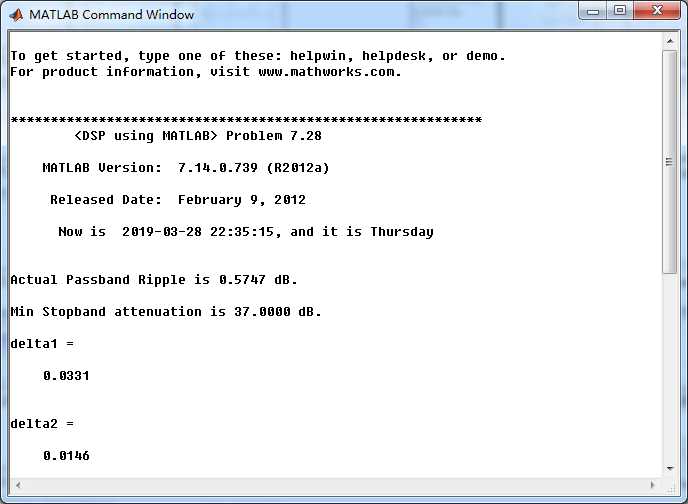
频率采样法,得到的脉冲响应、振幅响应和幅度响应:
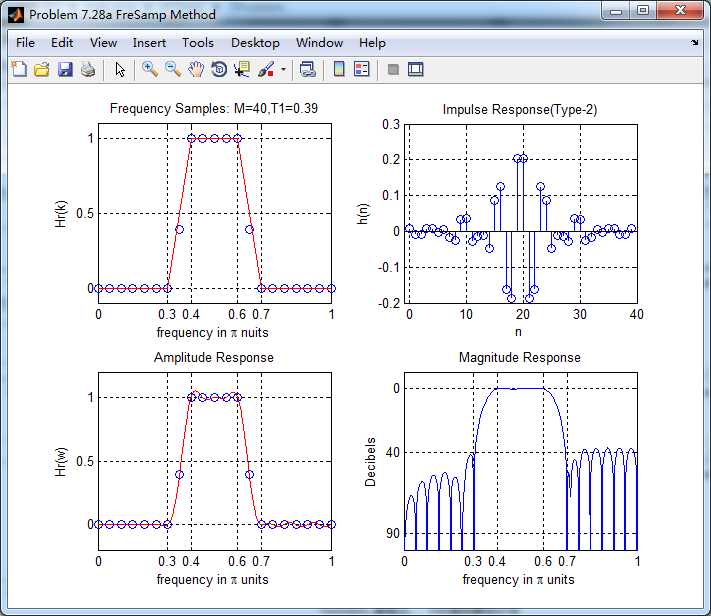
幅度响应、相位响应和群延迟
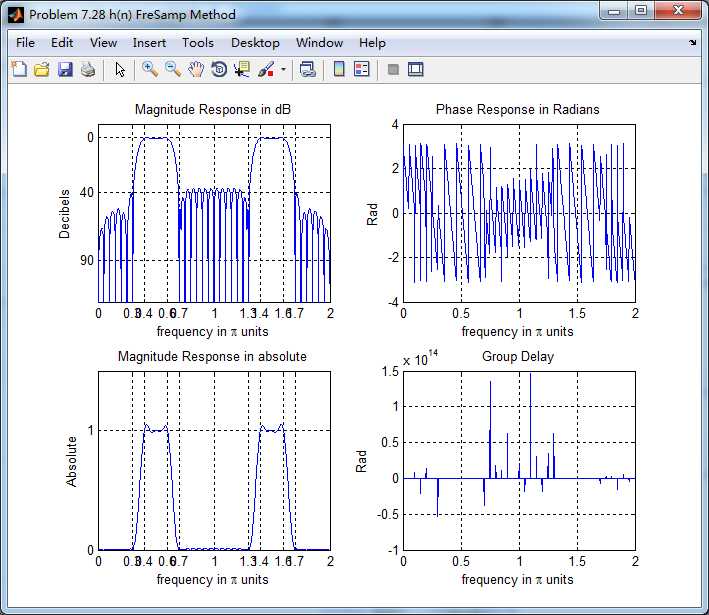
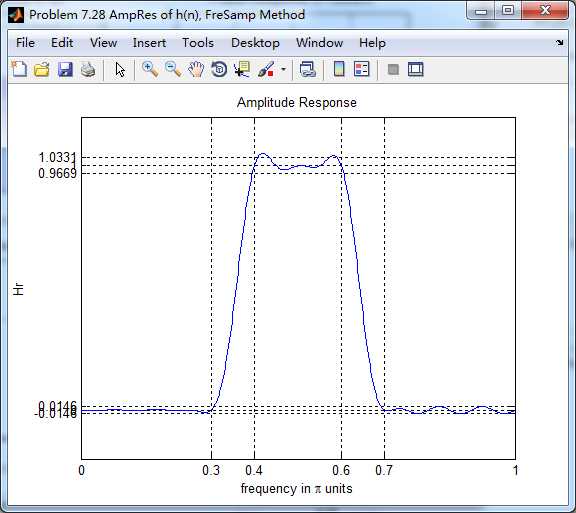
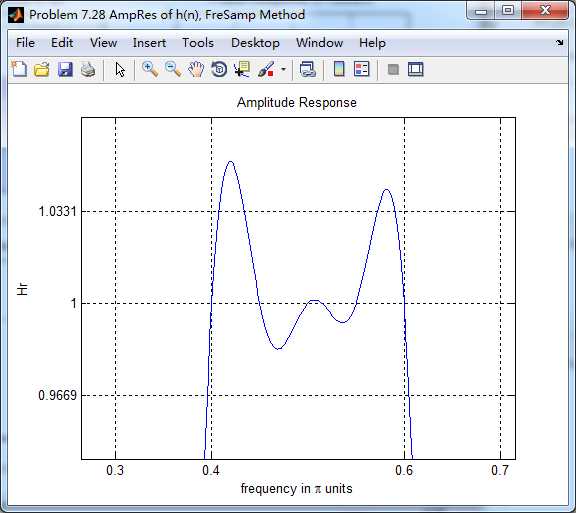
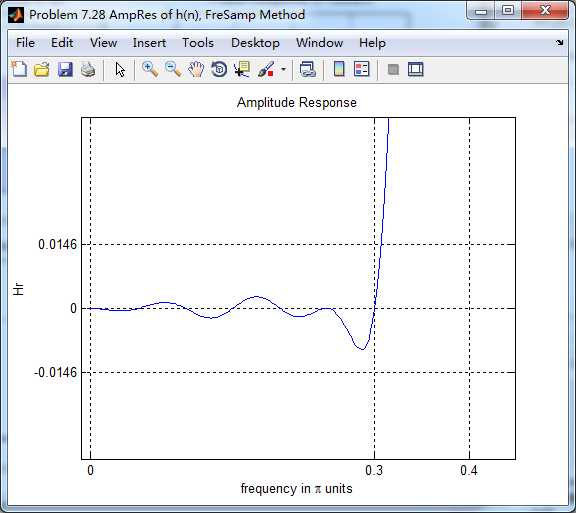
采用fir2函数求脉冲响应序列
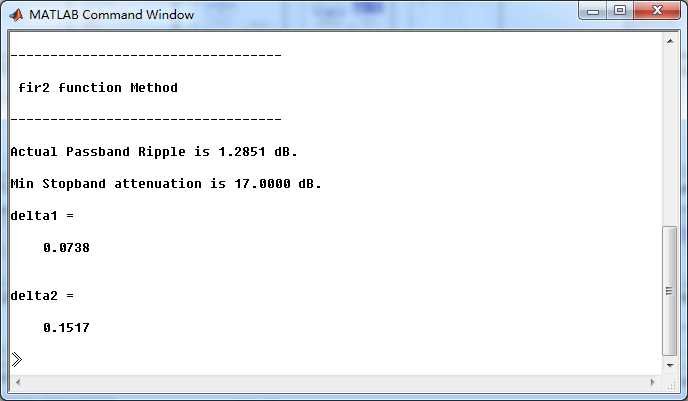

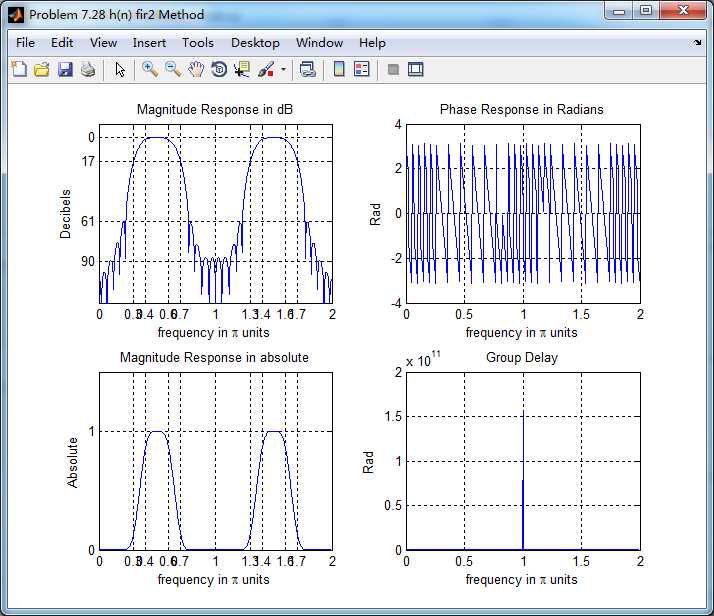
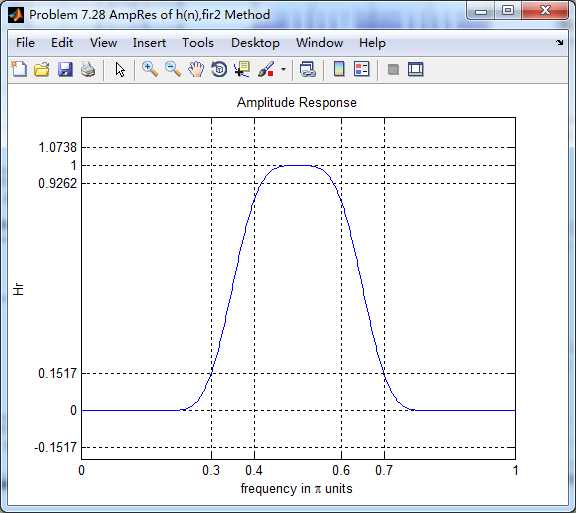
matlab自带的fir2函数比频率采样法得到的脉冲响应,通带和阻带的波纹ripple较小。
以上是关于《DSP using MATLAB》Problem 7.28的主要内容,如果未能解决你的问题,请参考以下文章
《DSP using MATLAB》Problem 3.12